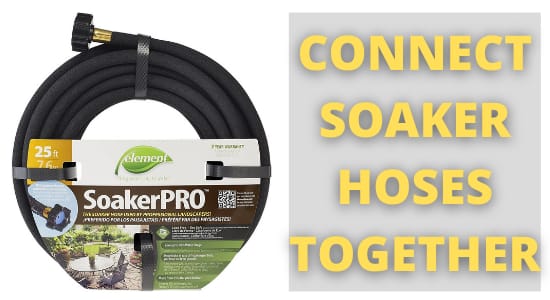Soaker hoses are tubes that soak into the area around them. Unlike the traditional hoses, they are porous, which allows water to seep along the total length of the pipe gently. But can you connect soaker hoses together?
Yes, you can connect various soaker hoses to create a system to suit your yard. Remember that the length will not exceed 100 feet. However, you can utilize pipe separators to lay pipes in diverse directions.
You can use short garden hoses for connecting impregnation hoses without frittering water. Read till the end to find out more about it!
Joining Soaker Hoses Together: A Detailed Discussion
Though you can join soaker hoses together, do not use any hoses which are 150 feet away from the water source. A poorly thought-out strategy for exceeding the 150′ limit is to increase the water pressure in your system. Be aware of using higher pressure as it may not bring good results.
Can You Connect Two Soaker Hoses Together?
Yes, if you have adequate pressure of water and small nozzles. Always work with a flow rate of about 6 liters per minute, and your application should be below this value.
You can try, but maximum hoses are designed with an inlet on the supply side, restricting water flow. It’s better to remove it before connecting a regular hose to the middle. Otherwise, it will be a problem.
Fill the rest of your hose. It creates uneven water pressure. Typically, soaker hoses require a different water collection every 50 feet to ensure a constant water supply.
How Do You Connect Two Soaker Hoses Together?
Connecting two soaker hoses can be pretty straightforward as screwing two ends together. The hose connector lets you combine different hoses together. Let’s go for the procedures.
Step 1: Arrange the Tools
The fittings must match your hose size. The diameter of the hose determines this. Most soaker hoses are 3/4″ or 1/2″ in diameter, similar to a garden hose.
If you have to replace the plug’s one side, you may cut the broken side and carry it to a hardware store. It will help you to buy the right variety.
Buy both the male and female connector if needed. Usually, male connectors are torn first, so they just have to be replaced. Also, you have to arrange a screwdriver, a knife, and a ruler or measuring tape.
Step 2: Cut the Hose Head
It is more comfortable to prevent any leaks if the hose ends in a clean, straight end. Use your utility knife for cutting the hose around 2 inches from the contemporary edge. To avoid jagged edges, cut it smoothly.
Step 3: Ready Your Hose
If your hose’s construction material is vinyl, try softening it before setting a new connector. Simply soak your hose in the warm water for a few minutes.
Step 4: Establishing a New Connection
It is slightly different based on the connection type:
Compression Accessories
It provides a more intimate seal and is more potent than alternatives. These accessories consist of a metal part with a round plastic space and an additional clamping ring.
First, pass the hose through the clamping ring. Then take the other part and insert your hose into the plastic space.
If you install the compression fitting, you may see that the fitting includes a round hole on its side to connect to your hose.
At this time, insert the hose and press it until it is flushed. Then place the ring throughout the connector.
Barbed Accessories
They are the easiest to set up and need no extra tools. But their lifespan is shorter.
In place of the separate ring, it has a pointed pin set that sticks inside the mouth of your hose. Insert the connector into the hose until it stops. This barbed fitting will prevent slipping.
Clamp Ring Accessories
Clamp ring components are usually more diminutive and more straightforward to install. Simply insert the cap into the opening of the hose.
Then put a ring on it. You may tighten its ring by rotating the side screw using a screwdriver.
Step 5: Connect Two Hoses
Those fittings can easily connect two hoses together. Just screw the plug into the socket. Ensure that the internal threads in the hose are evenly aligned.
Also, the cross-threads do not allow you to separate the fasteners and never break them. However, most commercial soaker hoses are 3/4″ in diameter.
Sometimes, you will need to attach one of these to a 1/2″ hose. In that case, you may need an adapter. Adapters are usually available in female and male sizes, which must match the connectors used.
Video Instruction – Connect Soaker Hoses Together
How Many Soaker Hoses Can You Connect Together?
In general, you can connect one or more soaker hoses together. In fact, you may join two expandable hoses at once. However, there are some technical details. Both the hoses must have a similar bore diameter and opposite female and male end to ensure a connection.
How Many Soaker Hoses Can I Connect?
You can connect multiple soaker hoses to fit almost any garden layout and creative design using bi-directional water valves and garden hoses. Be careful about the water pressure and distance to cover.
Final Verdict
Impregnation hose is helpful in that they supply water straight to the root zones of plants. The soaker hose is also best connected to the faucet with a conventional hose unless that faucet is in the stock you want to soak.
When passing the soaking hose over the bed, wrap it so that it passes through each plant. To reach each plant, you may unite hoses together. In that way, our article will be handy.

